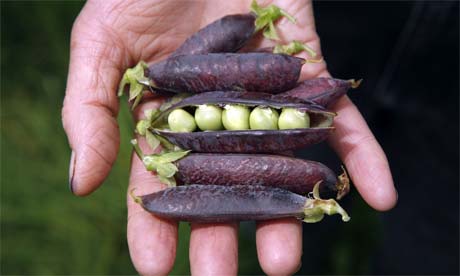*Purple (courtesy of the Guardian)

*Yellow (grown by me, years ago)

*Red (courtesy of the lovely Rebsie Fairholm)

*Bluish-green (no picture, sorry, but I am growing a couple of types with this colour so I can show you later in the year)
(Pods can also be discoloured due to orange colour in the parchment inside, and colours darkened or modified by other genes, but I'm not terribly interested in those.) The peas inside all these are green.
I'm not going to try to explain basic genetics here as I'm not a great teacher (there are plenty of resources online if you're interested, and I am happy to answer questions) but I will just define a few terms I'm going to use.
Gene: A single unit of genetic information, usually coding for one characteristic (like pod colour). There are several genes in the pea which affect pod colour.
Allele: One of a number of alternative forms of a gene. The gene that controls chlorophyll in pods has two alleles, Gp (normal green colour) and gp (yellow).
Dominance: One allele usually "masks" the effects of another if they are both present. If a pea plant has Gp (green pods) and gp (yellow pods), the dominant allele Gp "wins" and the plant will have green pods (it can pass the yellow pods allele on to its offspring though). The opposite of dominant is recessive - gp is recessive to Gp. Dominant alleles are signified by capital letters, or sometimes with the symbol +.
There are actually two ways to get red pods. The first is by combining the genes for purple pods with the genes for yellow pods. This sounds weird, until you realise that we're dealing with several different pigments which can either be present or absent in the pods. The purple-red colour is provided by pigments called anthocyanins, and when you get anothocyanins in a green pod the overall effect is purple. If you have anothcyanins in a yellow pod, the effect is red.
Three genes are involved here:
gp (recessive): Makes the pods yellow instead of green
Pu and Pur together (both dominant): Anthocyanin in pods
To get this combination, I'm going to make the following cross - Golden Sweet (yellow-podded snow pea, gpgppupupurpur, pictured above) x Purple Podded (shelling type, GpGpPuPuPur). What I expect to see in the F1 is purple pods, because all the plants will be gpGppuPuPurPur, but in the F2 we'll see a lot of variation. I expect 9/64 or 14% of the F2 plants to have red pods. 6/64 or 9% will likely have only one of the purple genes they need to be completely red - I don't know how that will be expressed but I predict that the pod will have a mottled or blushed effect with only a smaller amount of pigment. I'm looking forward to finding out anyway!
It would be lovely to get a red-podded snow pea so the red colour can be enjoyed in salads. For this I'll need to concern myself also with p and v (both reduce inedible parchment in the pod, with a completely edible pod requiring both). But that's for later.
The second way to get red pods is by combining the two purple alleles with one called b, which changed the structure (and therefore the colour) of anthocyanin molecules. Plants with b have pink flowers, whereas B plants have purple flowers. I haven't actually seen this combination, but I assume that the red will be somewhat "muddy" due to the fact that there's still green underneath. It's worth me trying a cross just to see what happens - I've been gifted a pink-flowered pea called Elisabeth which I presume has b by a fellow pea enthusiast (thank you Galina) and it's growing nicely now. Doing the cross Elisabeth x Purple Podded will get me the right combination. If Elisabeth is actually carrying a completely different flower colour gene, I'll make an alternative cross using one of the experimental materials I got from the Germplasm Resources Information Network (part of the US Department of Agriculture) which I know for sure definitely has b. The numbers are the same as above; 14% red pods, 9% (possibly) semi-red.
I have purple pods, yellow pods, green pods, and bluish-green pods already. Red pods will take a little more work.
No comments:
Post a Comment